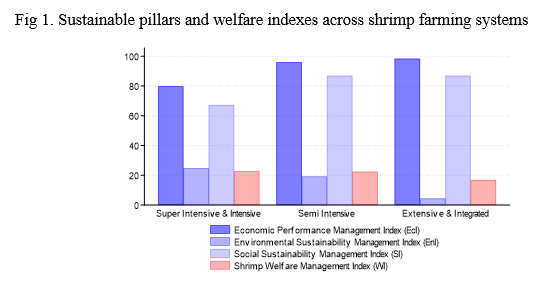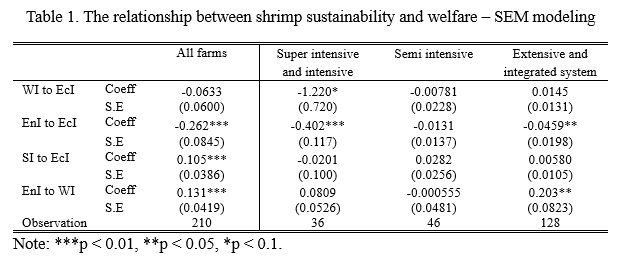ASSESSMENT OF INTERACTIONS BETWEEN SUSTAINABILITY AND WELFARE ISSUES IN VIETNAMESE SHRIMP FARMS
Introduction
Current researchers offer some analysis of welfare trade-offs with individual sustainability pillars, or sustainability pillar(s) and welfare; but rarely consider sustainability and welfare together. The challenges in aquaculture are, for example, while welfare improvements, they often conflict with environmental sustainability goals like resource conservation or effluent reduction; while prioritizing environmental objectives can sometimes undermine welfare outcomes, although welfare and environmental sustainability are closely aligned goals (Albalat et al. 2022) . T his research investigated the interactions among sustainability pillars and welfare management across various shrimp farming intensities, from extensive to super-intensive systems.
Materials and methods
Our work are conducted in the four main shrimp farming Mekong-delta Vietnamese provinces (Ca Mau, Bac Lieu, Soc Trang and Kien Giang, see Fig. 1). The surveys included 210 farmers who provided responses about their farms, with corresponding answers about their demographic and shrimp farm’s details in the year 2024.
To analyze the data, we utilized Principal Component Analysis to develop composite indices for sustainability pillars and welfare, with each index standardized to range from 0 to 100. Structural Equation Modeling was then employed to explore the interactions between sustainability and welfare across varying shrimp farming intensities. Accordingly, we follow SEM with the inner model as below (see attached image):
where ,
are the path coefficients representing estimating the strength of each relationship and
is the error term. The relationships are linear regressions within the structural model. In Eq.1, economic and welfare relationship by
(H1) examinate how shrimp welfare affects economic efficiency. Besides, the model from Eq.1 also highlights other key relationships: the environment and economic relationship by
(H2), and social influence economic performance by
(H3). Additionally, the model from Eq. 2 assesses the interaction between shrimp welfare and environment sustainability relationship by
(H4).
Results
Fig. 1 illustrates the mean values (range 0 - 100) of the sustainability (economic, environmental, social), and welfare management indexes across three shrimp farming systems . Overall, intensive farms require higher input costs and rely less on natural ecological processes while increasing their dependence on intensive feed and aeration, leading to the lowest economic index (Ngoc et al. 2023) . The environmental index is also less emphasized in intensive systems, as they focus more on maintaining pond water quality rather than promoting ecological balance. The shrimp welfare management index, however, is not much varied across all farming types, as econ-environmental priorities often take precedence over direct welfare investments.
Table 1 identified several important patterns in the interactions . In super-intensive and intensive farms, we observed a strong negative relationship between welfare improvements and economic performance, indicating that prioritizing welfare measures often incurs a financial trade-off. Across all farm types, environmental improvements were found to significantly reduce economic outcomes, with the most pronounced negative effect occurring in intensive farming systems. However, environmental enhancements were shown to significantly improve welfare outcomes across all shrimp farms, with the strongest positive impact observed in extensive and integrated systems.
Discussion and Conclusion
Extensive farming systems are often characterized by lower stocking densities and more natural rearing conditions, enabling shrimp to thrive in a more ecologically balanced environment. In contrast, intensive and semi-intensive systems typically prioritize productivity, which can increase disease susceptibility and stress for shrimp. As stocking densities rise, shrimp have less space to move, leading to reduced oxygen levels, higher waste accumulation, and greater pathogen transmission. These conditions ultimately increase the risk of shrimp to experiencing poor welfare if the systems are not well managed.
References
Albalat , A., Zacarias, S., Coates, C. J., Neil, D. M., & Planellas , S. R. (2022). Welfare in farmed decapod crustaceans, with particular reference to Penaeus vannamei. Frontiers in Marine Science, 9, 886024.
Ngoc, P. T. A., Le, V., Pham, T. T., Pham, H. C., Le, T. C., & Oude Lansink, A. (2023). Technical and scale efficiency of intensive white-leg shrimp (Litopenaeus vannamei) farming in Vietnam: A data envelopment analysis. Aquaculture Economics & Management, 27(1), 50-65.


